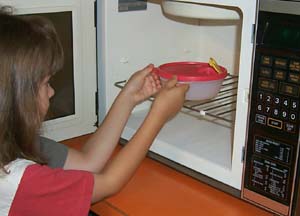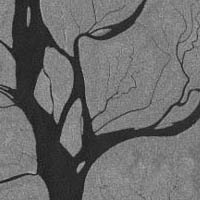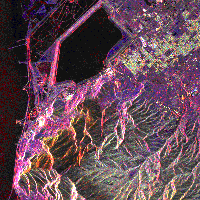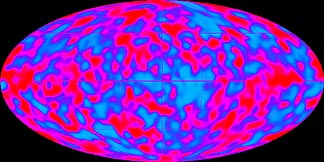|
Microwaves

| Microwaves have wavelengths
that can be measured in centimeters! The longer microwaves,
those closer to a foot in length, are the waves which heat our food in a
microwave oven. |
 |
|
Microwaves are good for transmitting information from one
place to another because microwave energy can penetrate haze, light rain
and snow, clouds, and smoke.
Shorter microwaves are used in remote sensing. These microwaves are used
for radar like the doppler radar used in weather forecasts. Microwaves,
used for radar, are just a few inches long.
|

|
This microwave tower can transmit information like telephone calls
and computer data from one city to another.
How do we "see" using Microwaves?
Radar is an acronym for "radio detection and
ranging". Radar was developed to detect objects and determine their
range (or position) by transmitting short bursts of
microwaves. The strength and origin of "echoes" received from objects that were hit by the microwaves is then
recorded.
| Because radar senses electromagnetic waves that are a reflection of an
active transmission, radar is considered an active remote sensing system.
Passive
remote sensing refers to the sensing of electromagnetic waves which did
not originate from the satellite or sensor itself. The sensor
is just a passive observer.
|
 |
What do Microwaves show us?


|
Because microwaves can penetrate haze, light
rain and snow, clouds and smoke, these waves are good for viewing the Earth
from space.
The ERS-1 satellite sends out wavelengths about 5.7 cm
long (C-band). This image shows sea ice breaking off the shores of Alaska.
|

 |
The JERS satellite uses wavelengths about 20 cm in length
(L-band). This is an image of the Amazon River in Brazil.
|
 
|
This is a radar image acquired from the
Space Shuttle. It also used a wavelength in the L-band of the
microwave spectrum. Here we see a computer enhanced radar image of
some mountains on the edge of Salt Lake City, Utah.
|
In the 1960's a startling discovery was made quite by accident. A pair of
scientists at Bell Laboratories detected background noise using a
special low noise antenna. The strange thing about the noise was that it was
coming
from every direction and did not seem to vary in intensity much at all.
If this static were from something on our world, like radio
transmissions from a nearby airport control tower, it
would only come from one direction, not everywhere.
The scientists soon realized they had discovered the
cosmic microwave background radiation. This radiation, which
fills the entire Universe, is believed to be a
clue to it's beginning, something known as the Big Bang.

The image above is a Cosmic Background Explorer (COBE) image
of the cosmic microwave background,
the pink and blue colors showing the tiny fluctuations in it.
|
Did you know that if you had a sensitive microwave telescope in your house
that you would detect a
faint signal leaking out of your microwave oven, and from
various other man-made sources, but also a faint signal coming from
all directions that you pointed it? This is the Cosmic Microwave
Background!
|
[NEXT LONGER WAVELENGTH] [NEXT SHORTER WAVELENGTH]
RETURN TO THE ELECTROMAGNETIC SPECTRUM
|










